Here I have a WPF application that is made with the MVVM structure. I am fairly new to C# WPF and am not familiar with this concept. I am attempting to switch to another view through a function in one view via the press of a button.
Here is what the application looks like,

Once the Login button is pressed a function is triggered that will validate the inputs and if valid switch to another view. Which would look like such,
File Structure
How can i switch the views ? Below are some code for reference.
MainWindow.xaml
<Window x:Class="QuizAppV2.MainWindow"
xmlns="http://schemas.microsoft.com/winfx/2006/xaml/presentation"
xmlns:x="http://schemas.microsoft.com/winfx/2006/xaml"
xmlns:d="http://schemas.microsoft.com/expression/blend/2008"
xmlns:mc="http://schemas.openxmlformats.org/markup-compatibility/2006"
xmlns:local="clr-namespace:QuizAppV2"
xmlns:viewModel="clr-namespace:QuizAppV2.MVVM.ViewModel"
mc:Ignorable="d"
Height="600" Width="920"
WindowStartupLocation="CenterScreen"
WindowStyle="None"
ResizeMode="NoResize"
Background="Transparent"
AllowsTransparency="True">
<Window.DataContext>
<viewModel:MainViewModel/>
</Window.DataContext>
<Border Background="#272537"
CornerRadius="20">
<Grid>
<Grid.RowDefinitions>
<RowDefinition Height="75"/>
<RowDefinition/>
<RowDefinition Height="25"/>
</Grid.RowDefinitions>
<Grid>
<Grid.ColumnDefinitions>
<ColumnDefinition/>
<ColumnDefinition/>
<ColumnDefinition/>
</Grid.ColumnDefinitions>
<TextBlock Text="Online Quiz"
Grid.Column="1"
FontSize="20"
Foreground="White"
HorizontalAlignment="Center"
VerticalAlignment="Center"/>
<StackPanel Grid.Column="2"
Margin="30,20"
Orientation="Horizontal"
HorizontalAlignment="Right"
VerticalAlignment="Top">
<Button Content="–"
Background="#00CA4E"
Style="{StaticResource UserControls}"
Click="Minimise"/>
<Button Content="▢"
Background="#FFBD44"
Style="{StaticResource UserControls}"
Click="Restore"/>
<Button Content="X"
Background="#FF605C"
Style="{StaticResource UserControls}"
Click="Exit"/>
</StackPanel>
</Grid>
<ContentControl Grid.Column="1"
Grid.Row="1"
Margin="20,10,20,50"
Content="{Binding CurrentView}"/>
</Grid>
</Border>
</Window>
MainViewModel.cs
using QuizAppV2.Core;
using System;
using System.Collections.Generic;
using System.Linq;
using System.Text;
using System.Threading.Tasks;
namespace QuizAppV2.MVVM.ViewModel
{
class MainViewModel : ObservableObject
{
public RelayCommand LoginViewCommand { get; set; }
public RelayCommand SubjectSelectionViewCommand { get; set; }
public RelayCommand QuizViewCommand { get; set; }
public RelayCommand ResultViewCommand { get; set; }
public LoginViewModel LoginVM { get; set; }
public SubjectSelectionViewModel SubjectSelectVM { get; set; }
public QuizViewModel QuizVM { get; set; }
public ResultViewModel ResultVM { get; set; }
private object _currentView;
public object CurrentView
{
get { return _currentView; }
set
{
_currentView = value;
onPropertyChanged();
}
}
public MainViewModel()
{
LoginVM = new LoginViewModel();
SubjectSelectVM = new SubjectSelectionViewModel();
QuizVM = new QuizViewModel();
ResultVM = new ResultViewModel();
CurrentView = SubjectSelectVM;
LoginViewCommand = new RelayCommand(o =>
{
CurrentView = LoginVM;
});
SubjectSelectionViewCommand = new RelayCommand(o =>
{
CurrentView = SubjectSelectVM;
});
}
}
}
LoginView.xaml
using QuizAppV2.MVVM.ViewModel;
using System;
using System.Collections.Generic;
using System.Linq;
using System.Text;
using System.Threading.Tasks;
using System.Windows;
using System.Windows.Controls;
using System.Windows.Data;
using System.Windows.Documents;
using System.Windows.Input;
using System.Windows.Media;
using System.Windows.Media.Imaging;
using System.Windows.Navigation;
using System.Windows.Shapes;
namespace QuizAppV2.MVVM.View
{
/// <summary>
/// Interaction logic for LoginView.xaml
/// </summary>
public partial class LoginView : UserControl
{
public LoginView()
{
InitializeComponent();
}
private void Button_Click(object sender, RoutedEventArgs e)
{
if (UsrId.Text == "" || UsrName.Text == "")
{
UsrIDErrMsg.Visibility = Visibility.Visible;
UsrNameErrMsg.Visibility = Visibility.Visible;
}
else
{
UsrIDErrMsg.Visibility = Visibility.Hidden;
UsrNameErrMsg.Visibility = Visibility.Hidden;
MainWindow.currentUser = new Student(UsrId.Text, UsrName.Text);
}
}
}
}
Thank you

